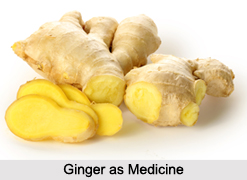 Ginger, botanically known as Zingiber Officinale has a very long history of use in various forms of traditional medicine. For thousands of years, many Indian healers have praised ginger as food and medicine.
Ginger, botanically known as Zingiber Officinale has a very long history of use in various forms of traditional medicine. For thousands of years, many Indian healers have praised ginger as food and medicine.
Benefits of Ginger
Ginger is described as acrid, heating, carminative and useful in dyspepsia, affections of the throat, head and chest, piles, rheumatism, urticaria, dropsy, etc. It is much used as a carminative adjunct along with black pepper and long pepper under the name of "Trikatu" or the three acrids. The dried root is called "Nagara" and "Mahaushadha" in Sanskrit. In addition to possessing the properties of ginger it is said to be laxative.
Dose of Ginger in Medicine
Ginger forms the active ingredient of several medicines for dyspepsia and hemorrhoids. In cephalalgia and other affections of the head, ginger juice mixed with milk is used as a snuff. The fresh juice of ginger taken with honey relieves catarrh, cough and loss of appetite. Ginger with salt taken before meals, is highly praised as a carminative. It is said to purify the tongue and throat, increase the appetite and produce an agreeable sensation.
Samasarkara Churna: Take cardamoms 1 part, cinnamon 2 parts, flowers of Mesua ferrea (nagakesara) 3 parts, black pepper 4 parts, long pepper 5 parts, dried ginger 6 parts, sugar in quantity equal to all the other ingredients; powder and mix. Dose should be about a drachm in dyspepsia, loss of appetite and piles.
Saubhagya Suni: Take clarified butter 16 tolas, milk 4 seers, sugar 6 seers and a quarter, dry ginger 1 seer; boil them together so as to make an electuary. Then add coriander 24 tolas, fennel seeds 40 tolas, baberang seeds, cumin seeds, nigella seeds, long pepper, black pepper, ginger, tubers of Cyperus rotundus, leaves called tejapatra, flowers of Mesua ferrea (nagakesara), cinnamon and cardamoms each 8 tolas in fine powder, and stir with a ladle till cold. This confection is much used as a carminative tonic in dyspepsia and in disorders of the alimentary canal in females after confinement.
Sunta Ghrita: This is a preparation of ginger made with a decoction and paste of the root, clarified butter and Kanjika in the usual proportions. It is said to be useful in rheumatism.
Ardraka Khanda: This is a confection made with ginger, clarified butter, milk and sugar with the addition of a number of aromatics in small quantities. It is used in urticaria.
Saindhavadya Taila: Take dry ginger 40 tolas, rock-salt, long pepper root and plumbago root, 16 tolas each, marking nuts 20 in number, fermented rice water 16 seers, sesamum oil 4 seers, boil them together and prepare a oil in the usual way. This oil is rubbed externally in sciatica and other forms of rheumatism.




















